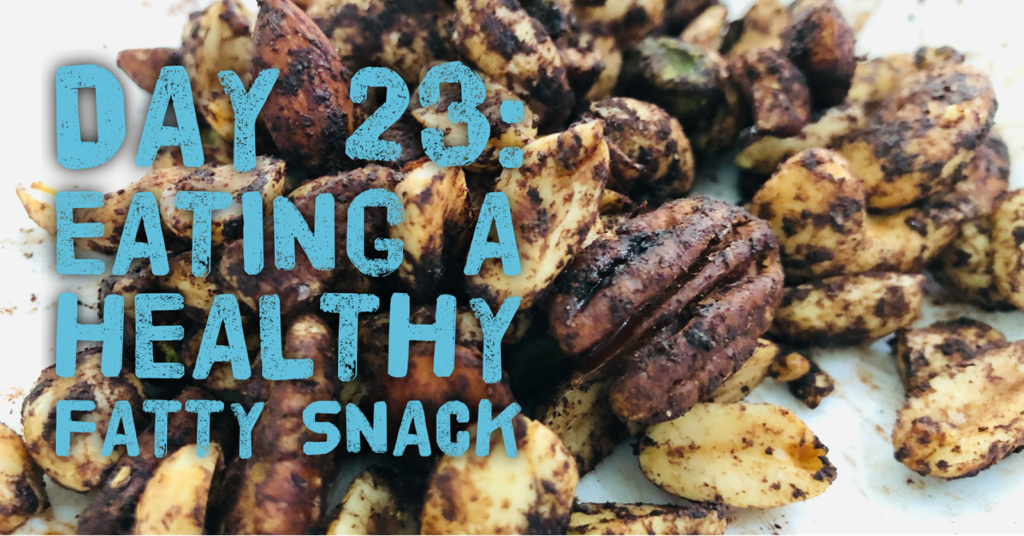Day 23: Eating a Healthy Fatty Snack
If you’re addicted to chocolates, and you realize, upon reading the label, that they contain more chemicals than your biochem lab, what do you do?
Take Sara, for example. When her dietitian asked her what she ate for snacks yesterday, she said, “Half a cup of M&Ms, the ones with nuts.”
That’s good, right? She had nuts and healthy anti-oxidant cocoa. Well…
We looked at the label-- one serving is 28 gms. Half a cup is 103 gms. So she consumed about 3.7 servings.
Each serving gives 140 calories, 15% saturated fat, and 13 gms (26%) of added sugar. So she had 518 calories and mostly coming from saturated fat and added sugars. To her chagrin, she also found out that the label listed ingredients she’s not very familiar with, like tons of food coloring (blue 1 lake, red 40, yellow 6, yellow 5, blue 1, red 40 lake, yellow 6 lake, yellow 5 lake, blue 2 lake, blue 2) and carnauba wax.
Can she eat healthier, affordable choco-flavored sweet nuts without these questionable ingredients?
Here’s a simple hack:
1/4 cup Virginia peanuts
1/4 cup mixed tree nuts
1 tsp vanilla
1-2 tsp cinnamon powder
1-2 tsp unsweetened cocoa powder
1 tsp honey
340 calories from the nuts + 20 cal from honey (about 5 gms of sugar composed of 38% fructose, 31% glucose, 1.5% sucrose = 360 calories.
Not only will you gain 2 points in your Mediterranean diet score, one for nuts and the other for legumes (peanuts), you also lower your calorie intake by 178 calories and increase your fiber intake without depriving your sweet tooth of your chocolate snack.
And one thing I learned is that it’s not all about calories. Even when a food is high in calories, if it is high in fiber, not ALL of those calories are absorbed by your body. That’s the difference between eating an ultra-processed, purportedly low-calorie food vs. a high fiber high-calorie whole food. I would choose the latter because you are getting quality calories, not empty ones.
Have you discovered any hacks to curb your sweet, high-calorie snacks with something healthier?
Take Sara, for example. When her dietitian asked her what she ate for snacks yesterday, she said, “Half a cup of M&Ms, the ones with nuts.”
That’s good, right? She had nuts and healthy anti-oxidant cocoa. Well…
We looked at the label-- one serving is 28 gms. Half a cup is 103 gms. So she consumed about 3.7 servings.
Each serving gives 140 calories, 15% saturated fat, and 13 gms (26%) of added sugar. So she had 518 calories and mostly coming from saturated fat and added sugars. To her chagrin, she also found out that the label listed ingredients she’s not very familiar with, like tons of food coloring (blue 1 lake, red 40, yellow 6, yellow 5, blue 1, red 40 lake, yellow 6 lake, yellow 5 lake, blue 2 lake, blue 2) and carnauba wax.
Can she eat healthier, affordable choco-flavored sweet nuts without these questionable ingredients?
Here’s a simple hack:
1/4 cup Virginia peanuts
1/4 cup mixed tree nuts
1 tsp vanilla
1-2 tsp cinnamon powder
1-2 tsp unsweetened cocoa powder
1 tsp honey
340 calories from the nuts + 20 cal from honey (about 5 gms of sugar composed of 38% fructose, 31% glucose, 1.5% sucrose = 360 calories.
Not only will you gain 2 points in your Mediterranean diet score, one for nuts and the other for legumes (peanuts), you also lower your calorie intake by 178 calories and increase your fiber intake without depriving your sweet tooth of your chocolate snack.
And one thing I learned is that it’s not all about calories. Even when a food is high in calories, if it is high in fiber, not ALL of those calories are absorbed by your body. That’s the difference between eating an ultra-processed, purportedly low-calorie food vs. a high fiber high-calorie whole food. I would choose the latter because you are getting quality calories, not empty ones.
Have you discovered any hacks to curb your sweet, high-calorie snacks with something healthier?
FAT CHALLENGE #3
Make your own chocolate snack using the above recipe as an example and be mindful of your ingredients’ nutrition label. Keep the saturated fat below 5% for each serving.

